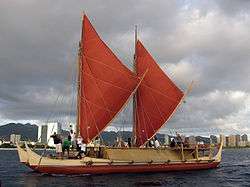Chialoup
Chialoup (or chaloup) was a type of sloop used in East Indies. It was the result of western (Dutch) and Nusantaran (Indonesian) technologies and techniques. Many of these "boat-ship" were produced at VOC shipwrights in Rembang and Juwana, in which the majority of the workers were local Javanese. Chialoup were used by the Dutch East India Company and private merchant-sailor of western and Nusantaran origin.

Description

The chialoup sails mimics the one used in sloop, which is a combination of square sails with a fore-and-aft type sails installed extensively. The boats are usually single-decked with one mast, sometimes added with a mizzen mast.[1]:34 While most of these chialoups use a European-style central rudder, some of them are equipped with two side (quarter) rudders, a characteristic of a Nusantaran boat. The length is between 15 and 25 m, with cargo bay reaching almost 6 m long. Depending on the size, crewed between 20 and 40 people. The load capacity was 40-80 last (72.4-144.8 metric tons).[2] In the syahbandar's (harbourmaster) record of Malacca there is even a chialoup carrying up to 200 t of cargo and a crew of 75 people.[3] Chialoups on average were armed with 4 cannons, 1 swivel gun, and 7 snaphaunces.[4]
In the era after 1820 chialoup gradually disappeared from "List of Ships and Sea Vehicles from East Indies" which was periodically published by the colonial government of the Dutch East Indies, and the term chialoup in newspapers was more rarely appeared, instead they were replaced with kotter, a Dutch word for a type of sloop.[5][6]:42
See also
References
- Knaap, Gerrit (1996). Shallow Waters, Rising Tide. ISBN 978-90-67-18102-0.
- Groenewegen, G. (1789). Verzameling van vier en tachtig stuks Hollandsche schepen : geteekend en in koper gebragt. Rotterdam: J. van den Brink.
- Lee, Kam Hing (1986): 'The Shipping Lists of Dutch Melaka: A Source for the Study of Coastal Trade and Shipping in the Malay Peninsula During the 17th and 18th Centuries', in Mohd. Y. Hashim (ed.), Ships and Sunken Treasure (Kuala Lumpur: Persatuan Muzium Malaysia), p. 53-76.
- Knaap, Gerrit (1999). "Shipping and Trade in Java, c. 1775: A Quantitative Analysis". Modern Asian Studies. 33: 405–420.
- Bruyn Kops, G.F. De 1921. 'Vaartuigen'. In: Stibbe, D.G. & Spat, C. (eds.) Encyclopaedie van Nederlandsch-Indië. ‘s-Gravenhage: Nijhoff.
- Liebner, Horst H. (2016). Beberapa Catatan Akan Sejarah Pembuatan Perahu Dan Pelayaran Nusantara. Jakarta: Indonesian Ministry of Education and Culture.


.jpg)